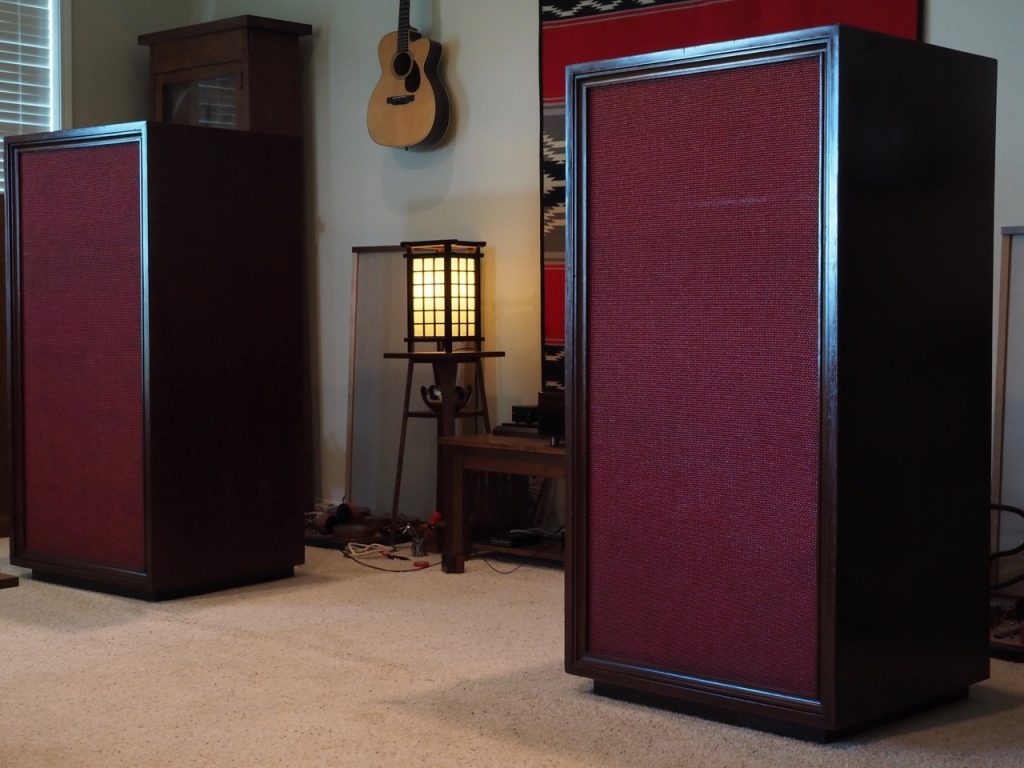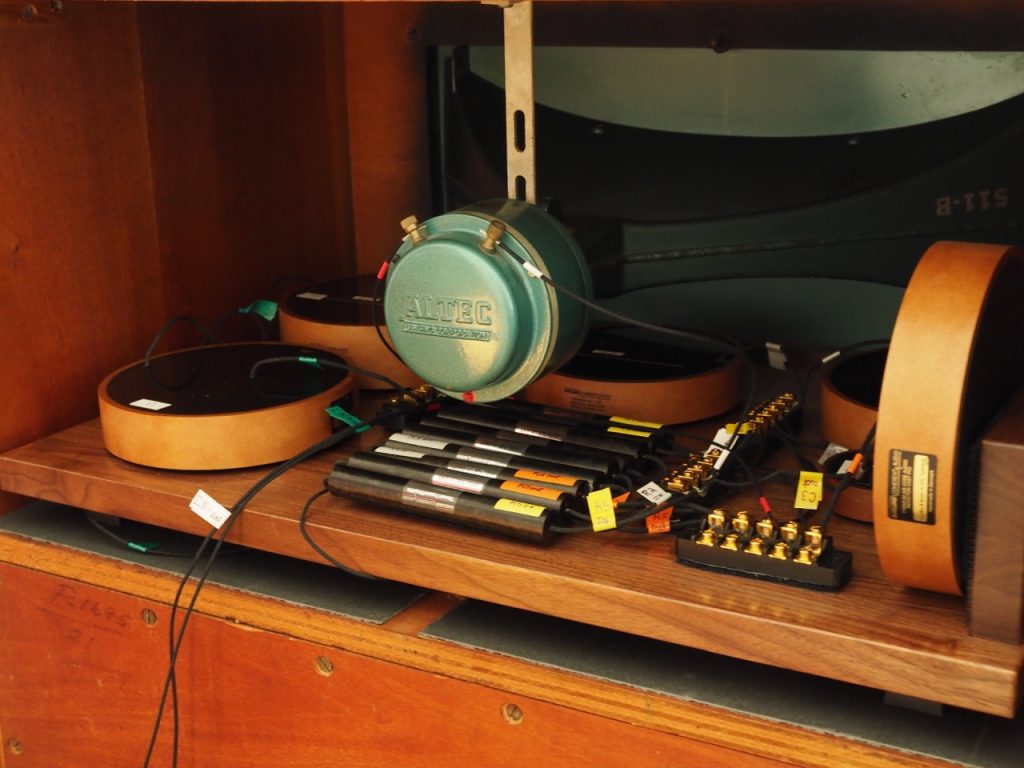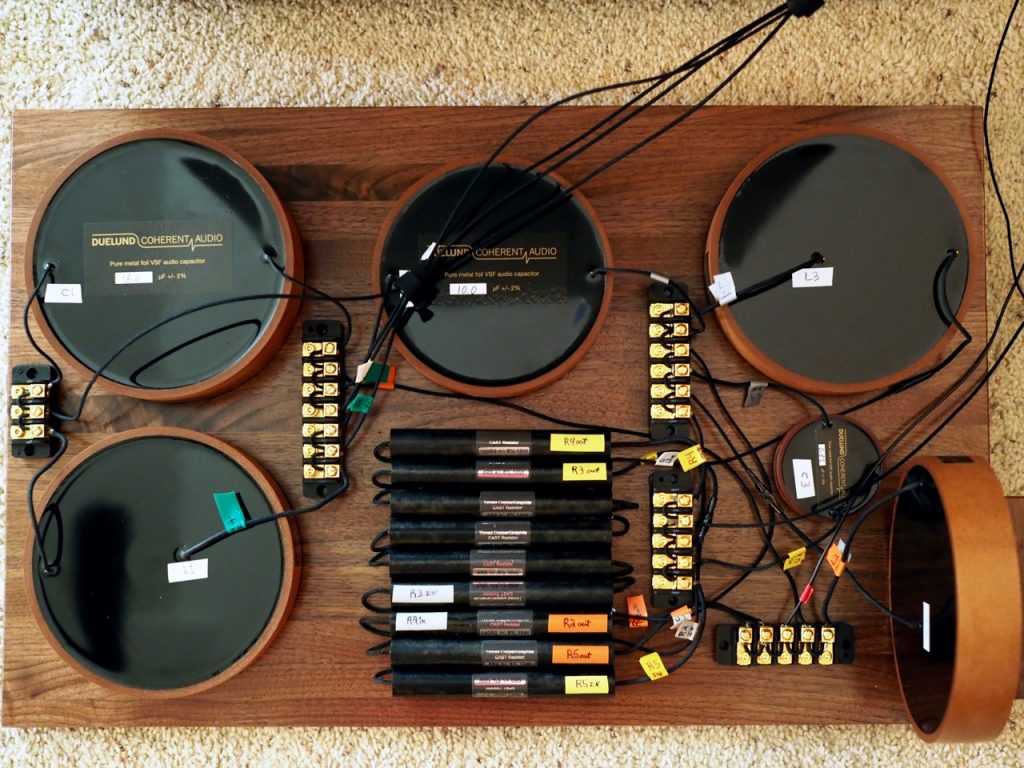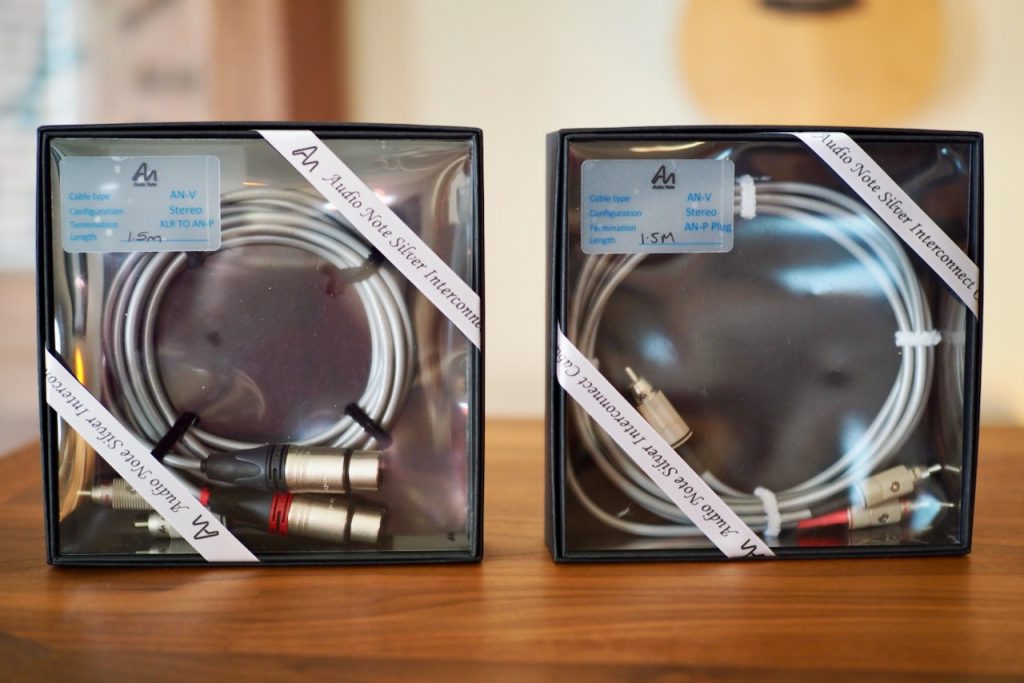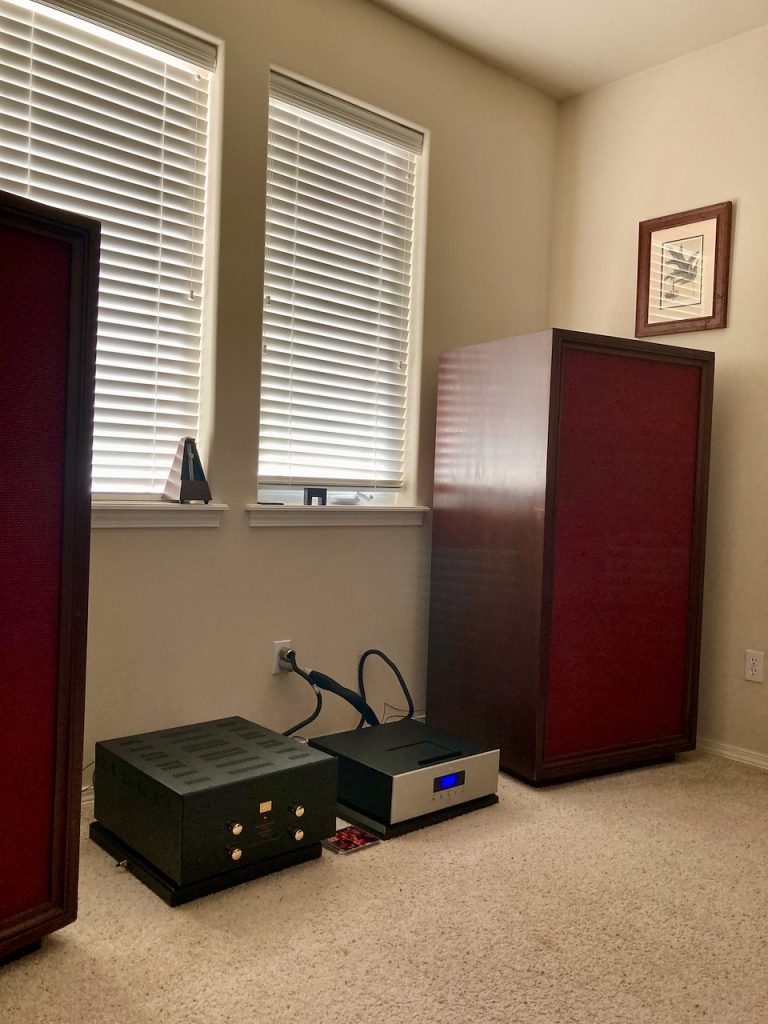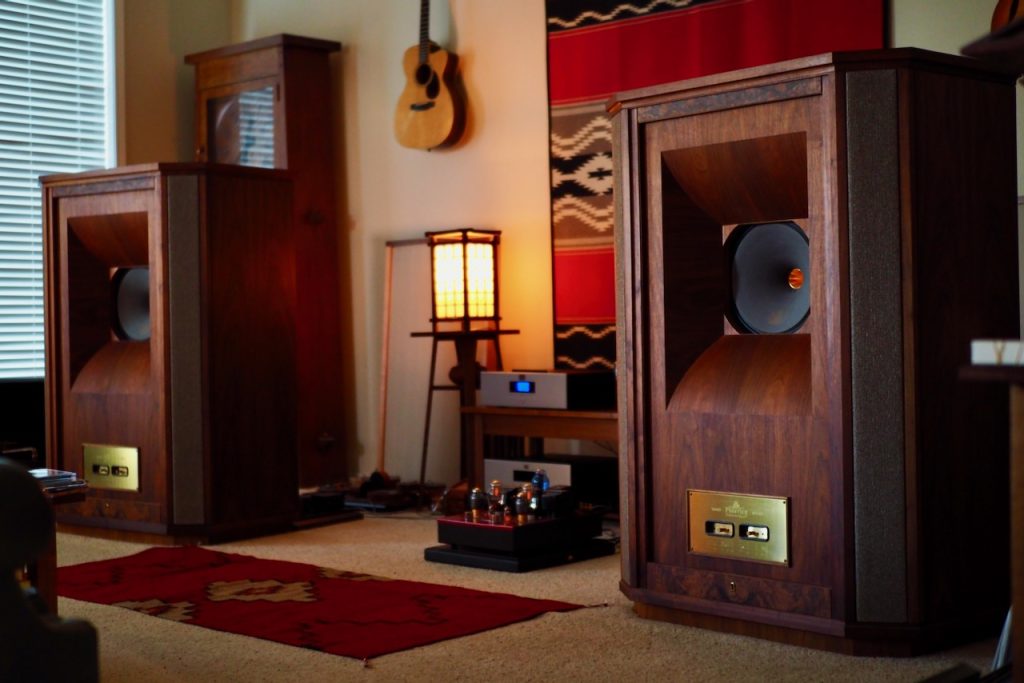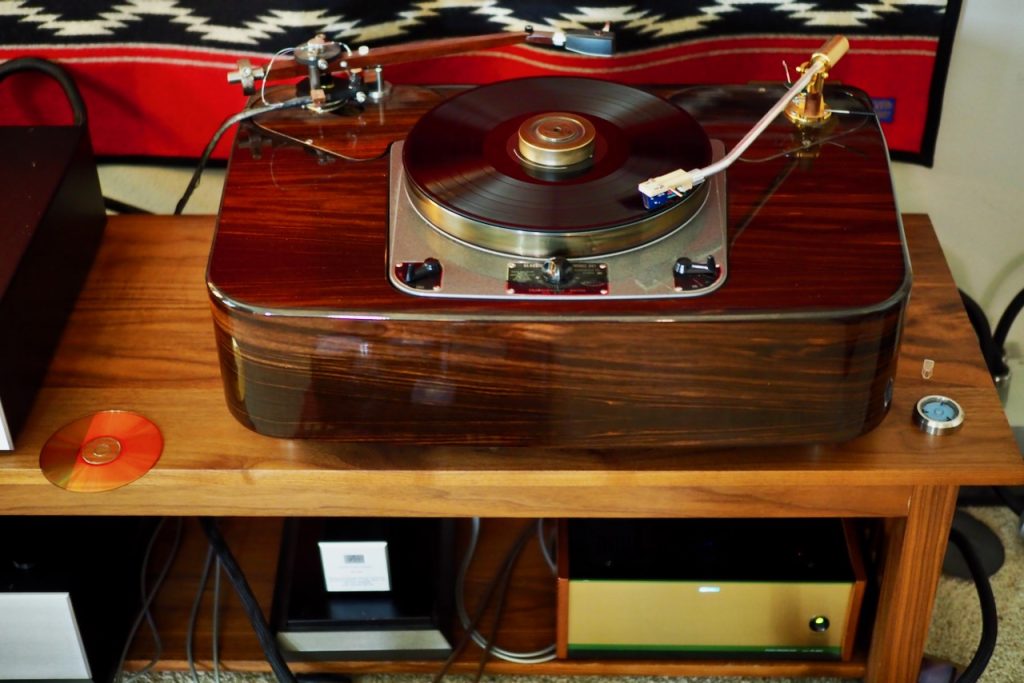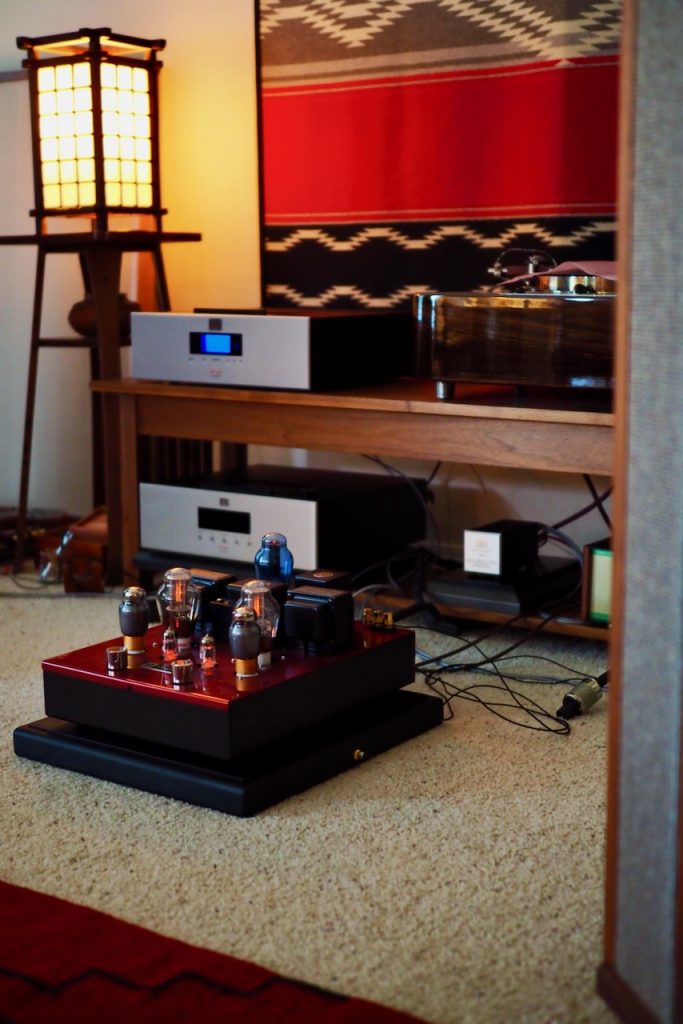I've had a long time passion for vintage Altec loudspeakers. At the moment I own three pairs: A pair of Altec A5 Voice of the Theatre loudspeakers in my audio-video system, a pair of Altec 832A Corona corner loudspeakers in my bedroom system, and the custom Altec loudspeakers that were built for conductor Leopold Stokowski while he was living in New York (The Duelund-Altec Project – Dare to Dream! HERE).
I've had the "Stokowski" Altec loudspeakers in storage for a while, until I recently brought them back into my home and placed them into my office / guitar room, so they wouldn't be subject to the brutally hot temperatures we increasingly see here in the summer months.
Those vintage Altec loudspeakers were given the deluxe Duelund CAST tinned-copper crossovers treatment, as described in the above linked article.
Unlike with my Altec A5s, the Stokowski Altecs Jean Hiraga 16-Ohm crossover circuit design wasn't optimized for room boundary placement, which really didn't matter as I intended putting them into the room for storage to keep them safe from heat exposure in the coming summer months, not to set them up as part of an audio system.
But ... you know how it goes, after looking at those lonely old Altecs for a while, curiosity got the better of me, and I placed them into room boundary positions (room corners) to give them a listen just to hear what would happen.
As I mentioned in a previous post, to power the Altecs I installed the Audio Note (UK) Meishu 300B amplifier that so wowed me with my Altec A5s, and the same sort of thing happened: The sheer musicality I was hearing from the Altecs & Meishu 300B amp combination pretty much blew me away, and that was with my regular ol’ Superscope PSD340 Music Practice CD recording system as a source (long out of production), that I've used occasionally when practicing the guitar. It's that positive Altec & 300B synergy you hear people talk about.
About this time, friend Santos dropped by for an impromptu listening session. We started our listening with the CD 5.1x CD player / Triode Lab 45 EVO SET integrated amp / Tannoy Westminster Royal SE loudspeakers combination in my living room.
About that system, while listening to CDs with the CD 5.1x, and vinyl with the CTC Garrard 301 / Io I MC cartridge / silver AN-V SUT / Leben RS-30EQ phono equalizer combination, Santos made the comment that the system "sounded better than any system any of us had ever heard" (referring to audio pals Doc Leo, Doc Wayne, and himself, that stopped by for a listening session a while back).
The system was indeed sounding very good.
Santos and I then spent a little time listening to the Altec / 300B / Superscope CD player combination in its room, with the Altecs in room-boundary positions, with us seated in relatively near-field positions about 8 1/2 feet from the loudspeakers.
Something rather unexpectedly remarkable happens when those big Altec loudspeakers are positioned in room-boundary positions with near-field listening positions, aided by the Meishu's 300B SET amplification: the big Altecs defy all expectations and disappear, with the listener immersed into the recording. One doesn't expect such large loudspeakers to disappear like that, but the Altecs did.
This combination of kit provided us a tonally beautiful, naturally warm, remarkably vivid & holographic, and eminently musical, listening experience.
Listening to this kit combination in a near-field room-boundary sort of system context was fascinating. The room boundary positioning compresses the depth of the soundstage compared to the more traditional audiophile positioning of my Westminsters in my living room (rule of thirds / fifths sorts of ideas), which accentuates encoded soundstage visuospatial information of magnetic era stereo recordings.
In my Altec A5 audio-visual system, the 300B Meishu SET integrated amplifier, which was designed primarily for Audio Note (UK) loudspeakers positioned in room boundary positions, has the rather remarkable ability to project information well in front of the plane of the loudspeakers into the room. The result being the listener is completely immersed into the recording, with visuospatial information appearing in front, to the sides, and even behind the listening position (with some video soundtracks).
I've never heard that kind of complete immersion into recordings from my 2-channel A5 based audio-visual system until the 300B Meishu came to visit.
Another fascinating aspect of the near-field room-boundary listening setup is that while stereo magnetic era recordings have a shallower depth perspective than with typical audiophile-style loudspeaker positioning, monaural recordings from the magnetic, electric, and acoustic eras of recording really bloom, sounding more musically natural in the width dimension in visuospatial terms than they do in an audiophile-style loudspeaker positioning context (which sort of compresses them in the width dimension), and taking on an almost magnetic era stereo-like visuospatial presentation with regards to images arrayed across and into the soundstage.
A near-field room-boundary listening setup might be the way to go for those who prefer a more natural presentation of the soundstage from monaural recordings of the acoustic, electric, and magnetic eras of the recording arts. Food for thought.
Santos also remarked to me how with this Altec & 300B combination, the big Altec loudspeakers just unexpectedly disappeared, and as listeners we were placed into the ambient field of the recording so that it surrounded us, as well as remarking on the vividness and naturalness of the images on the soundstage.

Audio Note (UK) Meishu Phono Silver Tonmeister 300B SET integrated amplifier and the CD 4.1x CD player.
Today I installed the Audio Note (UK) CD 4.1x CD player along with their intended Audio Note (UK) AN-V silver interconnect cables, that Darko Greguras had sent me to try in comparative listening sessions with the CD 5.1x CD player that is in for review.
I've been trying to get the minimum recommended run-in time of 200 hours for the AN-V interconnects topped off for both pairs of the AN-Vs in preparation for the upcoming review of the CD 5.1x CD player (the balanced to RCA terminations for the CD 5.1x, and the RCA to RCA terminations for the CD 4.1x).
It's taking me longer than expected to get the run-in time topped off for the AN-V interconnects, as it takes some doing to get 200 hours of run-in time into each pair of interconnects, but all is still progressing nicely.
Darko had mentioned to me that the silver AN-V interconnects would start off sounding very laid back, then transition to a harsher forward sort of sound, before finally settling back down with a naturally transparent sounding high-fidelity presentation.
I've got the most time on the balanced-to-RCA terminated AN-V interconnects for the CD 5.1X CD player, and they have traversed the two preliminary run-in states, and are settling in to their final voicing rather nicely.
The RCA-to-RCA terminations of the AN-V interconnects for the CD 4.1x CD player have traversed the laidback run-in state, and are somewhere in the harsher sounding state at the moment, as they move towards settling into their final voicing.
One of the nice things about the Audio Note (UK) CD players is their vacuum tube amplification stages, which allows the listener to choose vacuum tubes that best complement their listening preferences.

Audio Note (UK) Meishu Phono Silver Tonmeister 300B SET integrated amplifier, and the CD 4.1x CD player with Amperex Holland ECC88 vacuum tubes installed.
In the CD 4.1x I've done a little experimenting with alternate ECC88 tube choices, and at the moment am enjoying the overall presentation provided by the NOS Amperex Holland ECC88 tubes I've installed in it.
The CD 4.1x is of course many levels above the performance of my Superscope CD recorder/player that I had listened to in this system with Santos.
The combination of the 300B Meishu SET amp and the CD 4.1x really impressed me with the Altecs, with their already impressive performance synergy improving considerably.
Before too much longer the Meishu will transition into my Westminster loudspeakers based system for the upcoming feature review of the CD 5.1x CD player for Positive Feedback.
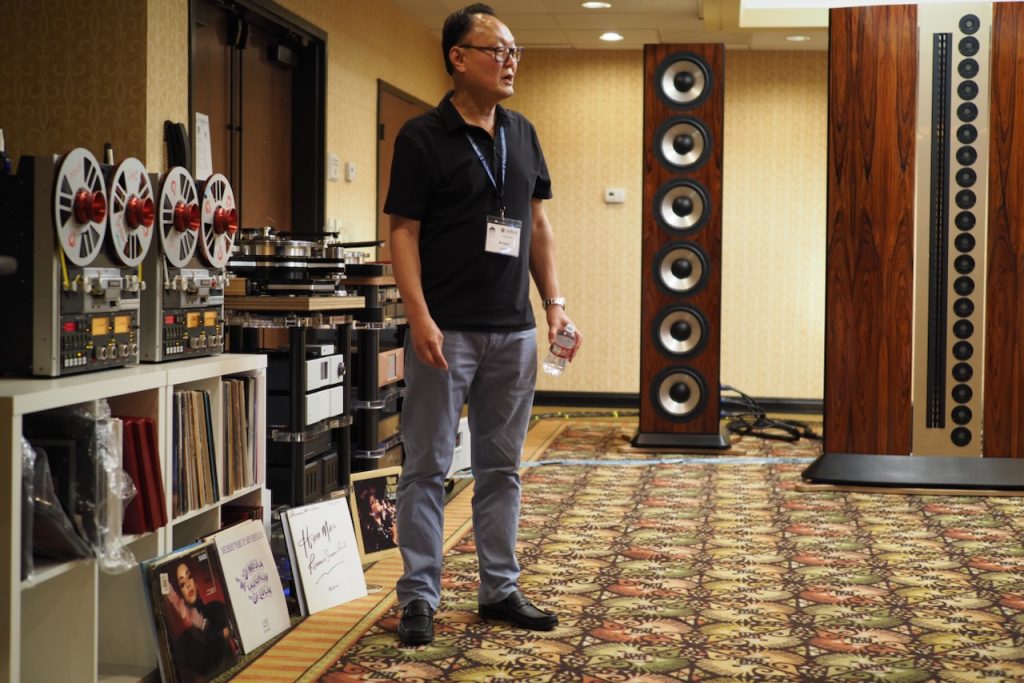
The Genesis room at the Pacific Audio Fest 2022. Demonstrations with R2R master tapes, digital copies, vinyl, and so forth.
Time for a little musing about the recording arts and the audio playback arts.
These days, the majority opinion among audio industry leaders is that the hierarchy of high-fidelity sources tends to follow the order of magnetic era stereo master tapes played back on quality reel-to-reel machines as being the top performer, with high-resolution digital transfers of said master tapes played over quality transport-DAC combos being a very close second, with stereo magnetic era recordings optimized for vinyl playback being a slightly more distant third, and with master tapes optimized for CD playback rounding out the formats in fourth place.
To add to that perspective, there's a sort of orthodox audiophile dogma that evolved over the stereo magnetic era of recording that proposed the ultimate goal in high-fidelity recording was be able to accurately reproduce the sound quality of the original recording session, whether studio or live (an altogether worthy goal).
However, in the recording arts, whether recording a live performance or a studio recording, a perfect copy of the musical performance waveform is not considered to be possible.
In physics there is a concept known as the observer effect, which says that when we are measuring something, our act of measuring alters the accuracy of the measurement.
In our recording arts example, the microphone is the observer, and as good as some of the best microphones are, they can't perfectly capture/measure the sound waves of the frequency spectrum of human hearing without slightly (or not so slightly) altering them.
Each component in the recording and playback pathways also alters that signal being measured by the microphone, and the more microphones / components there are, the more alteration there is that occurs, which is in accordance with the propagation of error calculations that every scientist and engineer learns in the introductory courses to their particular disciplines.
So that means that you're never going to hear exactly that 'absolute sound' of the original musical performance from a recording.
While the absolute accuracy goal of orthodox audiophilism is a laudable idea, it is ultimately out of reach from a technology perspective.
There are those remarkable high-fidelity recordings that come closer than others in conveying the musicality, visuospatial environment, and emotional impact of the recording sessions of musical performances, and they are indeed very satisfying to listen to, so enthusiasts still have reason to rejoice.
I have come to view the recordings we listen to as music and audio enthusiasts as collaborative works of art between the musicians and the recording arts.
Now if we move outside of the world of orthodox audiophilism, there are other considerations as to what high-fidelity might imply for our listening enjoyment.
For example, many musicians and music lovers listen to music from a somewhat different perspective than do audiophiles, in that they are more concerned with the quality of a musical performance than they are with the quality of a recording.
To understand this sort of difference, peruse the music reviews in Gramophone compared to audiophile generated sound quality oriented reviews of albums. In Gramophone you'll read about recorded musical performances from all the eras of the recording arts that are highly praised because of the quality of the musical performance, rather than their recording quality.
The music lovers that read Gramophone, for example, often enjoy listening to a wide variety of recordings that span the eras of the recording arts: the acoustic era (1860 to 1925), the electrical era (1925 to 1945), the magnetic era (1945 to 1975), and the digital era (1975 to the present).
Over the last few years I have been falling increasingly into the habit of listening to albums from all of the eras of recording too, with their variable levels of fidelity, low to high. I have been throughly enjoying immersing myself in the artistic experience of said albums, much in the same way I might enjoy the visual art forms of painting, drawing, sculpture, and so forth.
So in some ways my listening focus is converging with my sensibilities for broader art appreciation, but in my case that extends beyond the visual arts to the musical, recording, and audio playback arts.
Now lets go back to the majority opinion about the hierarchy of audio sources for a moment.
As terrific as master tapes from the stereo magnetic era of recording can be (or quality copies of them), it is difficult for most enthusiasts to assemble a music library of them featuring a wide selection of albums. The same can be said for the high-resolution digital transfers from those master tapes, there just isn't a large selection of albums to listen to.
So from my perspective, as someone who enjoys albums from all the eras of the recording arts, those are formats that greatly limit a listener to a very small percentage of Planet Earth's recorded music canon.
For me, the two most viable software formats are vinyl records (which I have been devoted to for a rather long time), and more recently CDs. That is because those two formats provide me access to the greatest number of recordings that span all the eras of the recording arts.
With vinyl records one has a fairly wide selection of available titles from the monaural and stereo magnetic eras of the recording arts, and while they are not quite at the peak of fidelity that listening to master tapes (or their copies) on a quality reel-to-reel machine are, they still can be very good, and very enjoyable to listen to.
In the past I have had a fairly low opinion of CDs, but my opinion has changed due to a couple of factors that are important to me, and now I tend to favor CDs as a format even above vinyl records.
First, with CDs, these days you can find a great number of albums from all the eras of the recording arts, making it much easier to assemble a library containing many of the important recordings from the history of the recording arts that compose our recorded music canon.
Secondly, with CD players optimized to extract the maximum amount of music from CDs, like those from Audio Note (UK), for example, CDs too can be extremely enjoyable to listen to.
From a high-fidelity perspective, I suppose my hope is that a unicorn CD player will appear that will provide a level of fidelity and listening satisfaction that rivals or exceeds that of vinyl records. A unicorn CD player would have all the high-fidelity benefits of the best vinyl record playback, and possibly more, but expand listening possibilities to albums from all the eras of the recording arts, in the highest fidelity they are capable of delivering.
While my listening impressions are still preliminary, the Audio Note (UK) CD 5.1x integrated transport and DAC (CD player) may very well be that unicorn. More on that to come.
Generally speaking, as we have progressed through the eras of the recording arts, the fidelity of the recordings have improved in terms of frequency response, dynamic response, resolution, and so forth (although the ultimate fidelity of the digital era of recording seems to be still evolving, I have high hopes for it as it continues to mature as a viable recording format).
While I have very much enjoyed a variety of approaches to the audio playback arts, in particular I have enjoyed loudspeakers of relatively high sensitivity, like my vintage Altec loudspeakers (above), or my more contemporary Tannoy Westminster Royal SE loudspeakers (below), combined with single ended triode amplification.
Those great musical performances recorded during all the eras of the recording arts seem to be at their considerable best when listening with high-sensitivity loudspeakers, SET amplification, vinyl record playback ...
... and now I'll add CD playback to my preferences, as a quality CD player expands listening choices to recorded musical performances from our entire recorded music canon, which for me are essential to my overall listening enjoyment.
Ok, that's enough musing for now.
As always, thanks for stopping by, and may the tone be with you!




